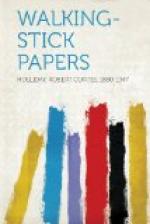The most popular way of presenting the baby at the cheap photographer’s,—seated, standing, on his back, or on his belly; stark naked, or (as sometimes he is found) girded about the loins, or (as, again, he is seen) less naked and wearing an abbreviated shirt, and in various other stages of habilimentation,—is on a whitish hairy rug. No background but the hairy rug. It is background (very largely), one suspects, that gives one the sense of a baby’s value. The idea occurs to a thoughtful observer of his photograph that it is to a considerable degree from background, surrounding atmosphere, local colour, that the baby derives personal identity. Twenty cabinet-sized naked babies, each on a hairy rug:—one conceives how an unscrupulous photographer (as may very likely commonly be the case) might save money on negatives, after he had a stock of a little variety, by snapping babies with an unloaded camera and printing from old plates, without anybody’s being the wiser. (Here, indeed, would be a utilitarian motive behind the baby’s being naked of articles of identification.) It is, alas! undermining to the pride of race to reflect that that photograph of one’s cousin’s fine new baby Edward, which reminded every one so much of the infant’s mother, may not impossibly have been the original likeness of some baby now long extinct.
History, so called, deals exclusively with persons of distinction; fiction, though more catholic, sees man in a glamour, with the various prejudices this way and that of a mortal eye. The development of the discovery announced by Daguerre in 1839, and first applied to portraits by one Draper,—this is the great historian. The photograph business, sir, alone sees life steadily and sees it whole. Photography is the supreme sociologist, master psychologist. In the sidewalk display of the cheap photographer is the poor, naked, human story,—poignantly touching, chastening of pride, opening the heart of the responsive beholder to deeper knowledge of the inherent kinship of all humankind.
How does the consummate realism of the cheap photographer show its babies of yester-year, clothed now in the raiment of mature years and simple honours?




